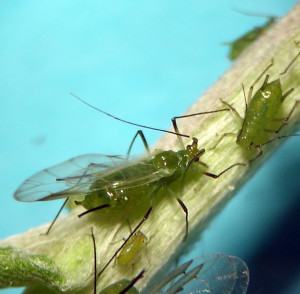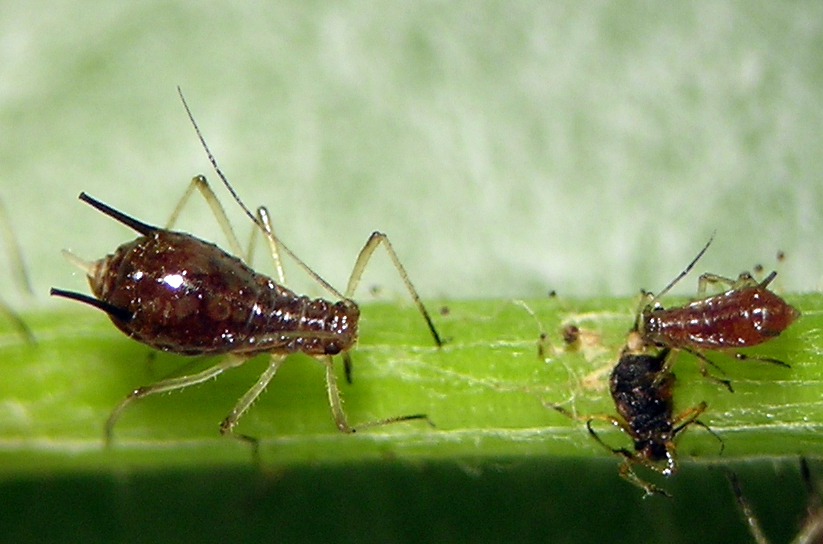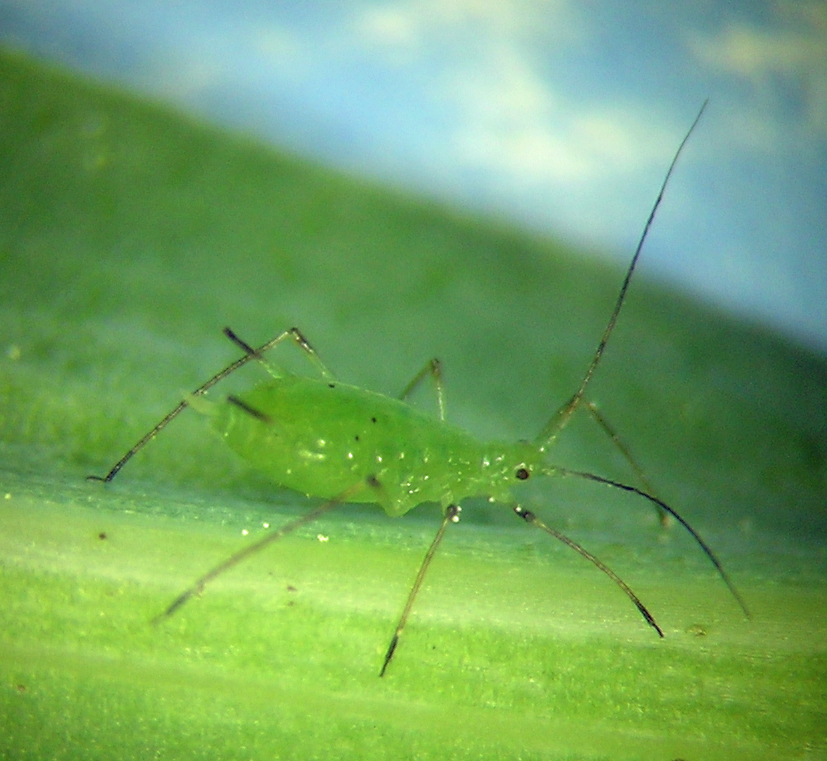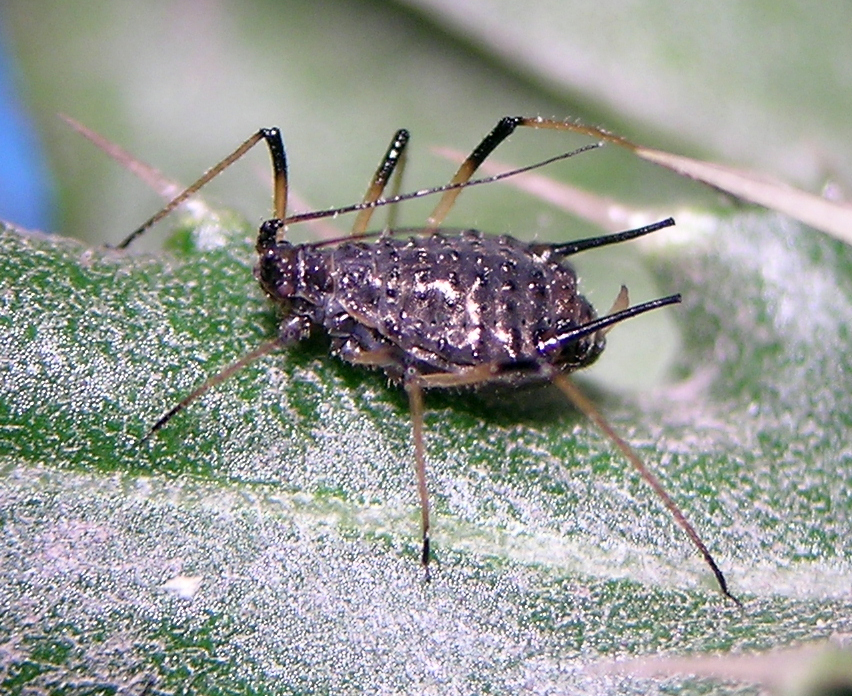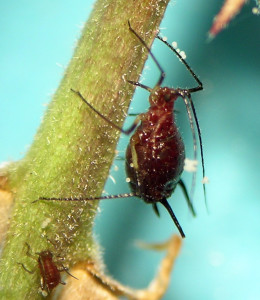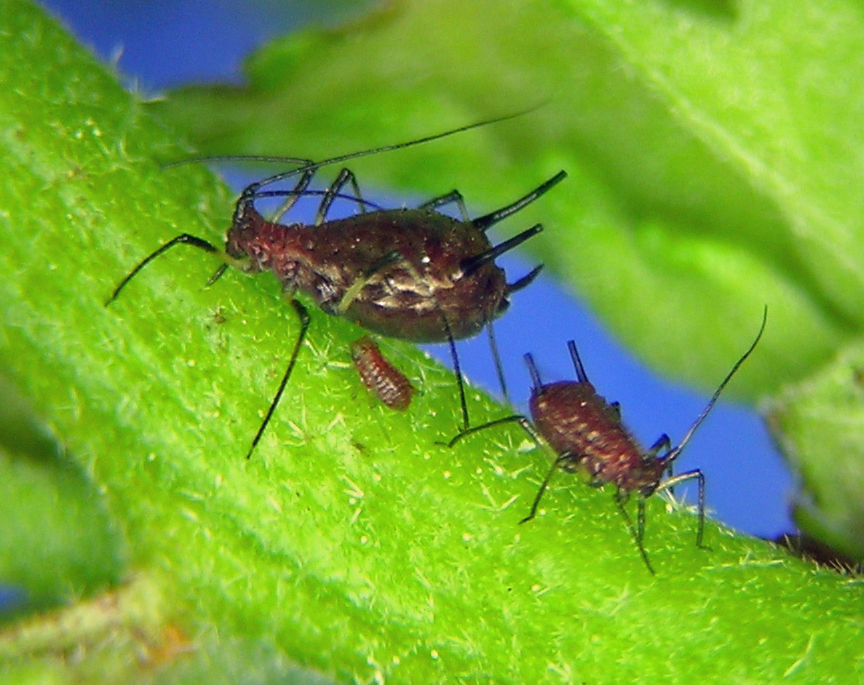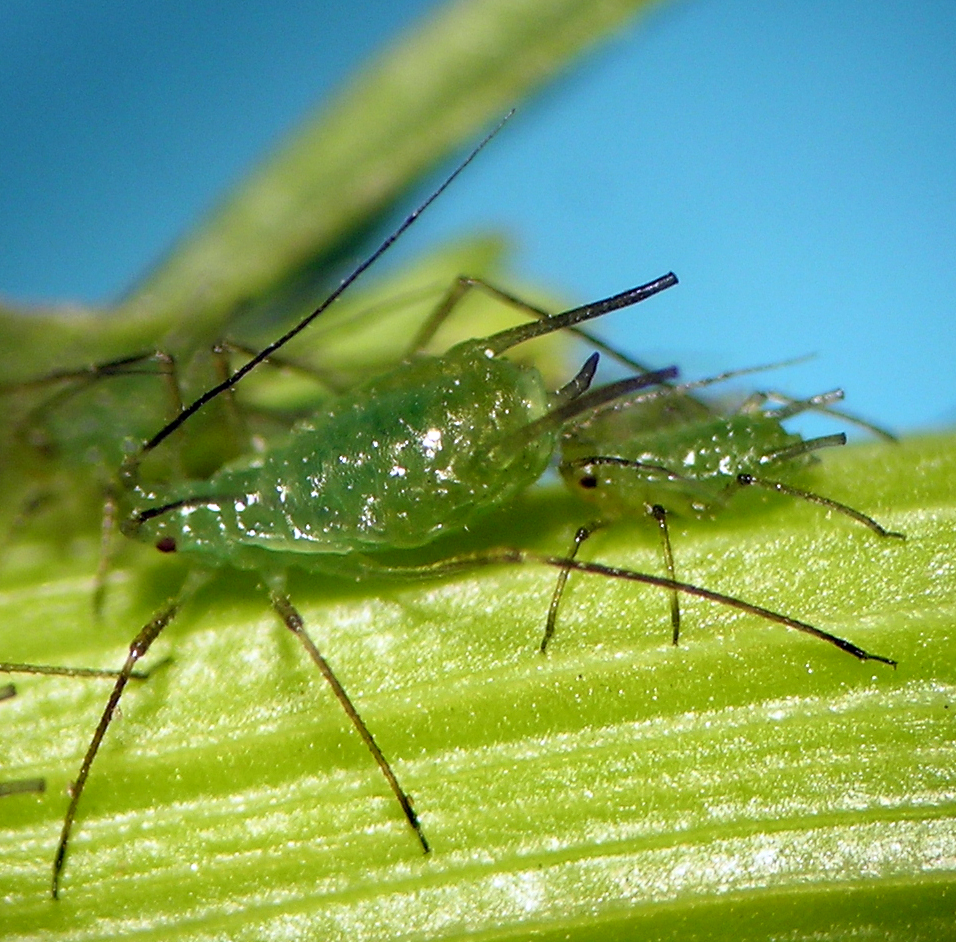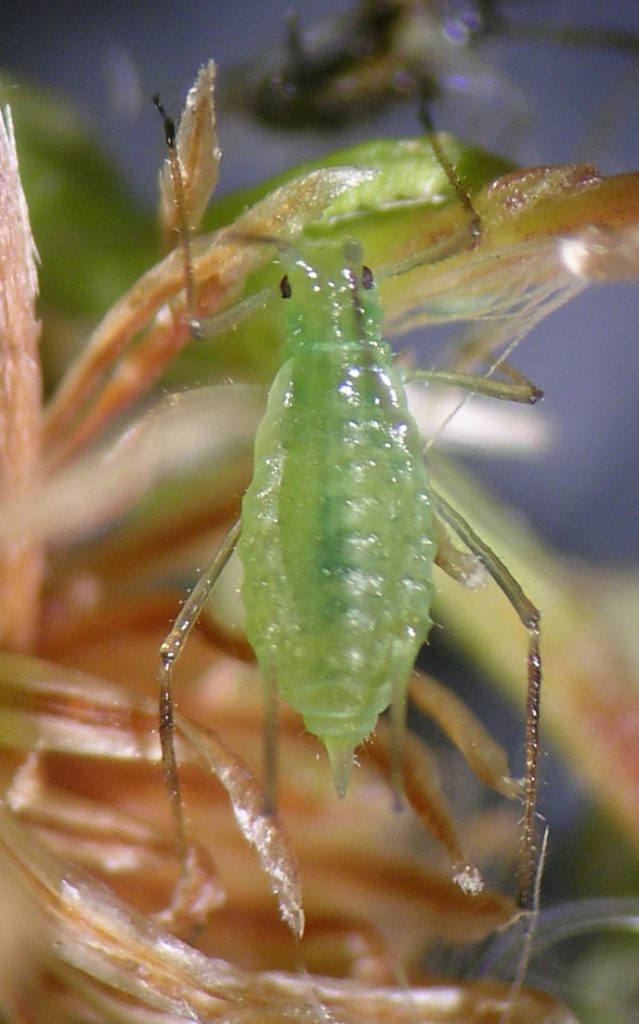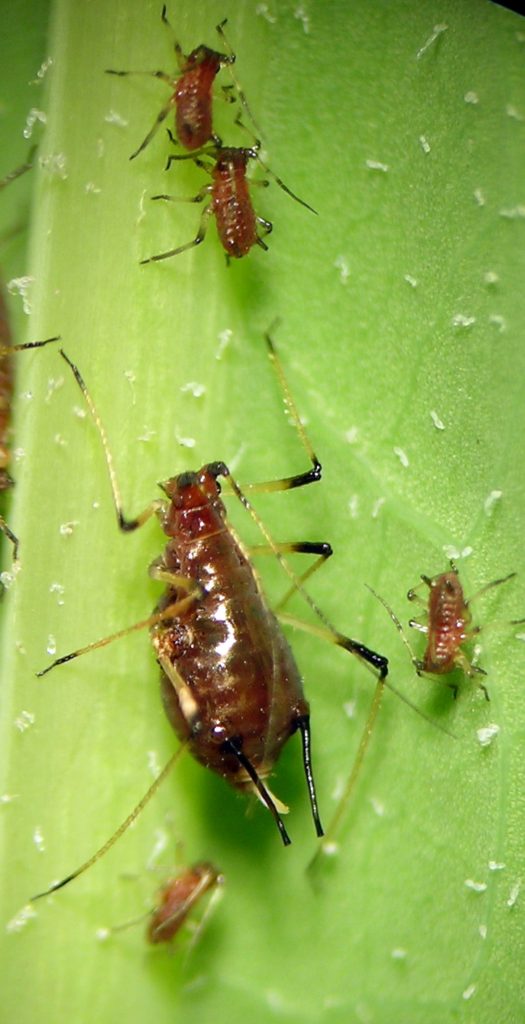Uroleucon Mordvilko
This page updated: December 2024.
Here is another huge, messy genus with species-level taxonomy in a shambles, at least in some parts of North America. Almost all the species feed on Asteraceae and are monoecious. I actually published a short paper with some co-authors on one common species with a very wide host range, Uroleucon (Lambersius) erigeronense (Thomas).
Jensen A.S., G.L. Miller, A. Carmichael. 2010. Host range and biology of Uroleucon (Lambersius) erigeronense (Thomas 1878), and its synonymy with Uroleucon (Lambersius) escalantii (Knowlton 1928) (Hemiptera: Aphididae). Proceedings of the Entomological Society of Washington 112: 239‑245.
Since then I continue to collect Uroleucon in the west, especially focusing on the subgenus Lambersius. A few years ago I found an impossibly small U. (Lambersius) in the mountains of southern Oregon, but the season was so late that I could not identify the plant at all. Finally in 2018 I was able to collect this aphid again on its host plant while in bloom. Turns out the host is Aster integrifolius in sagebrush steppe at high elevations. This aphid is very small, a strange mottled pale green, and has Macrosiphum-like siphunculi, but is probably most related to some other species placed in U. (Lambersius). Another interesting 2018 find was a bright yellow species feeding among the flowers of goldenrod along a forest roadside in southern Oregon. The interesting thing about this was that it was tended by ants! Aphids shaped like Uroleucon are very rarely ant-tended (ant tending is correlated with short appendages and cauda).
During December of 2021 I sat down and sorted numerous undetermined slides of U. (Lambersius); I also sorted some rows of slides with species names on them. I was able to place some undetermined material in named species, while simultaneously removing some slides from named species and placing them into the various groups of like specimens in my undetermined boxes. These species name changes have appeared in the slide collection database.
Based on all this study of U. (Lambersius) in western North America, two things seemed possible: 1) this subgenus of aphids are mostly not particularly host-specific, or 2) there are a LOT more species out there than we currently believe, and separating those species based on morphology will be nearly impossible. In addition, species of this subgenus, even when confidently identified (as confident as can be hoped for in this genus), are frustratingly variable morphologically.
Further work on U. (Lambersius) based on 2022 and 2023 collecting made me continue to feel that either the species are insanely variable morphologically, or that there are numerous undescribed and unrecognizable described species. I now have about 20 sets of samples that are not identified to species but can be separated from each other and don’t key out to known species. In 2023 I was 99% convinced that our local Uroleucon (Lambersius) species are mostly not host-specific but may instead have preferred hosts with many other plants that are acceptable. This creates a huge challenge for aphid taxonomy since we rely so heavily on host specificity in our identification keys. An interesting example from 2023 was collecting on an unidentified Erigeron in the local piñon pine/juniper desert. It was fall, the season for sexuales. I noted that a few specimens could be found on each healthy-looking Erigeron plant, and that the specimens looked smaller than, and distinct from, the usual U. (L.) erigeronense-like specimens I find in these deserts. So, I gathered several specimens. Upon mounting and examination, these seem to mostly fit the species Uroleucon (Lambersius) zerogutierrezis (Smith & Knowlton). This species’ normal host, Gutierrezia, is common in the area, but no aphids were found on it. So, my hypothesis was that what we call U. (L.) zerogutierrezis prefers, in the specific context of our desert habitat and given the weather of 2023, this Erigeron species for production of sexuales. I saw a similar phenomenon in the deserts of central Washington when I was studying U. (L.) erigeronense: sexuale production on the annual plant Conyza followed by fundatrix development in early spring, long before Conyza starts growing, on perennial Erigeron species. A new explanatory idea emerged in 2024, however, during my sorting of about 60 new undetermined slides of U. (Lambersius). As I looked through dozens of slides of material all collected close to home in similar habitats and on a handful of common plants, I realized that some of the groupings I was using were essentially displaying morphological features that were intermediate between various distinctive species in the region. For example, the case just mentioned of aphids living on an Erigeron that looked like U. (L.) zerogutierrezis — yes, they looked like this species, but with one major exception: the rhinaria on a.s. III were clumped in the basal 2/3 of the segment rather than on the apical 3/4 of the segment as in U. (L.) zerogutierrezis. Rhinaria concentrated toward the base is the more common feature in Uroleucon of the region, including aphids found just meters away. Other examples included specimens that look mostly like U. (L.) erigeronense except with a short broad ultimate rostral segment as in U. (L.) zerogutierrezis. Or, specimens like U. (L.) erigeronense except with tarsi a bit too short and with long spinelike setae ventrally, features in some distinctive species such as the unusual U. (L.) nevadense Robinson, which feeds on Brickellia microphylla. So, the idea that came to mind was that perhaps what I am seeing is the result of hybridization among what we know of as species of Uroleucon (Lambersius) in this region, resulting in a smear of variation and no clear host plant affiliations. Of course I cannot be sure which hypothesis, or perhaps neither, is correct.
Another indicative point here is the text about U. (L.) zerogutierrezis on Blackman and Eastop’s website: “On Gutierrezia sp. in western USA and on G. sarothrae in Mexico (Nieto Nafría et al. 2011). There are also records from Bidens, Senecio and Chrysothamnus, but there is possible confusion with U. erigeronense, to which it is very similar in every respect except the antennal rhinariation.” Personally, I find this species to be very different from U. (L.) erigeronense; it is much smaller overall, with short siphuncli that bear unusually large reticulations, and the ultimate rostral segment is unusually short and broad for this genus. So, am I looking at the same species that they looked at? Or, is this species so variable that some samples are wonderfully distinct from U. (L.) erigeronense while others are almost indistinguishable? Or, were they looking at some kind of hybrid population? Any of these cases is an indictment of our current understanding of Uroleucon (Lambersius) species.
As noted by A.G. Robinson back in the 1980s, the only way to figure out this subgenus in North America will be to get accurate host plant identifications, to species, on every collection, and to make detailed color notes and conduct host plant transfers among hosts.
Species covered below (click on the name to jump to that species):
- Uroleucon adenocaulonae (Essig)
- Uroleucon (Uromelan?) bonitum (Hottes)
- Uroleucon (Lambersius) breviscriptum (Palmer)
- Uroleucon cirsii (L.)
- Uroleucon (Uromelan?) eoessigi (Knowlton)
- Uroleucon (Lambersius) erigeronense (Thomas)
- Uroleucon (Lambersius) longirostre (Gillette & Palmer)
- Uroleucon russellae (Hille Ris Lambers)
- Uroleucon sonchi (L.)
Uroleucon adenocaulonae (Essig)
In the northwest of North America there is a plant called Adenocaulon bicolor, or ‘trail plant.’ There is a host-specific aphid that lives on it called Uroleucon adenocaulonae. Like many aphids, I have an affection for this species, partly due to its wonderful forest habitat and partly due to its bizarre posture in life, facing head down on the plant stems but with the back legs and body dangling, almost making the insect look dead. I have viviparous females, oviparae, and apterous males. So far I have samples from Oregon, Washington, California, and Idaho.
This species offered a great example of just how good aphids are at finding their host plants. In the forest near Lakeview, Oregon Adenocaulon is extremely uncommon. In fact, during the 5+ years collecting in that area I found Adenocaulon only once, and this was in a deep, cold, steep-sided stream drainage. The patch of plants was perhaps the size of a living room, and there, many kilometers from its nearest conspecifics, lived U. adenocaulonae.
Uroleucon (Uromelan?) bonitum (Hottes)
This species is native to western North America where it feeds on native species of Stephanomeria, an unusual xeric-adapted plant of sagebrush and salt-bush steppe. A plant that is superficially similar is the invasive rush-skeleton weed. The question mark on the subgenus is taken from Blackman and Eastop, and is probably because this species seems not particularly closely related to most other U. (Uromelan). I have seen it quite a few times now on what are almost certainly at least two species of Stephanomeria; samples in my collection are from Washington, Oregon, Nevada, Arizona, Colorado, and New Mexico.
Uroleucon (Lambersius) breviscriptum (Palmer)
I have collected what I call this species quite a few times over the years. It seems to live on Aster but almost certainly more than one species of Aster. I had recently been suspecting that there may be two species in my row of slides with this name on them. During December of 2021 I sorted these specimens, and many other U. (Lambersius). I was able to confirm a clearer understanding of what this species looks like, and pulled out some of the specimens to go into other categories in my collection (other species, or into undetermined blocks of specimens). In life this aphid looks an awful lot like U. (L.) erigeronense and so I may well walk past it from time to time in an effort to limit additions to my massive holdings of the latter species. So far I have material from British Columbia, Washington, Oregon, California, Idaho, Utah, Wyoming, Colorado, and Montana.
Uroleucon cirsii (L.)
This is a common European species that feeds on Canada thistle, Cirsium arvense, especially west of the Cascade Mountains in western North America. I have collected it in Washington and Oregon and confess to walking past quite a few possible collections due to it being a European invasive.
Uroleucon (Uromelan?) eoessigi (Knowlton)
This is another of my favorite aphid species, simply because it took me so long to find it. When Knowlton described it in 1947, he had seen it and received samples from many places in the Rocky Mountains where it was collected in people’s yards on ornamental hollyhock (Alcea rosea – a native of China). For over 20 years I have looked with interest at every hollyhock I see, thinking surely this aphid must be found some day, or Knowlton had somehow been wrong about the host. In 2010 I collected a dark red aphid in the Blue Mountains of Oregon that in terms of genus placement looked like Macrosiphum more than it looked like Uroleucon when mounted on slides. Yet, certain characters forced me to consider it as likely Uroleucon. At the time, I thought the host plant was a Geranium, leaving me at a dead end on species identification.
The second time I found this aphid, I decided to collect the plant and make sure it was really a Geranium. Turns out it was a Sidalcea (checker mallow), the same family as ornamental hollyhock (Malvaceae). This put me onto the true species identification, Uroleucon eoessigi. Since then I have seen this species here and there on Sidalcea and in one season it was incredibly abundant on Iliamna, a wild hollyhock locally common in the mountains near Boise, Idaho. Like many aphid species, this one seems to go through many seasons of being very rare, with an occasional season of overwhelming abundance. The 2016 season in southern Oregon near Lakeview was another strong one for this aphid — it was on Sidalcea almost everywhere we went from early spring through leaf drop in late September.
The question mark above attached to the subgenus name is copied from what Blackman and Eastop did — I assume they had the same concerns about generic affiliation that I have. So far I have specimens from Oregon, California, and Idaho.
Uroleucon (Lambersius) erigeronense (Thomas)
As I noted above, this is the species of Uroleucon I’ve actually published on. I noticed early on in my aphid studies that Uroleucon (Lambersius) seemed to feed on many different species of Asteraceae in the Northwestern U.S., and that almost all of them keyed out to U. erigeronensis.
For many years I thought that small differences in morphology that I saw might indicate that there were many different, host specific species involved. In the 2000s, however, I studied this aphid in the sagebrush steppe of central Washington and saw clearly that all these slight variations in morphology did not relate to separate species. I remember one decisive collecting day in the Potholes Revervoir area: I saw this aphid in great numbers on several plants in the same locality, including the rabbitbrush shrubs, Crepis, and more. Since then I have seen that it often enters winter as eggs on the skeletons of late-blooming plants like Conyza canadensis or Ericameria nauseosus, but might actually get going with spring development on more ephemeral herbs that I tend to lump in genera such as Aster, Erigeron, Crepis, and Hieracium (to name a few). In the steppe around my central Washington home, this species would move from species to species as they bloomed and senesced, eventually finishing the season once again on Conyza and Ericameria.
This species is known as monoecious, but it is certainly migratory among its many host plants. One common sight is U. erigeronsis alate viviparae settling and starting colonies on ephemeral Asteraceae at very high elevations, on the edges of wind-swept cliffs, and on the edge of receding snowbanks. These alates obviously
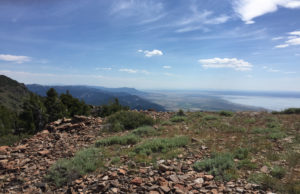
migrate from lower elevations each season to colonize these resources that otherwise would not be available to aphids.
I have collected this aphid hundreds of times, and walked by many hundreds more possible collections. The list of genera I have recorded it from is very long, and would be longer were I better taxonomist of Asteraceae. To see a list of plants I’ve recorded this aphid from, see my collection database.
Uroleucon (Lambersius) longirostre (Gillette & Palmer)
This is a species that feeds on native thistles (Cirsium spp.) in western North America. Like many aphid species, a person can look at hundreds of native thistle plants between finds of this aphid. It is easy to recognize by its host plant choice and its very long ultimate rostral segment. I was lucky enough to find the fundatrix of this species while clambering down a rocky trail in central Washington in April. I have samples from Washington, Oregon, Utah, Colorado, New Mexico, and Arizona.
Uroleucon russellae (Hille Ris Lambers)
Another of the few native Uroleucon species that is widespread and somewhat common in western North America, this species feeds on the common composite Anaphalis, and is distributed across much of northern North America. I have material from the mountains of British Columbia, Washington, Oregon, Idaho, Colorado, and Quebec.
Uroleucon sonchi (L.)
This is one of the more common and easily noticed aphids on the planet. And, it now lives in most parts of the planet. It lives mostly on Sonchus (i.e. sowthistles), but I have collected on cultivated lettuce as well in a mixed assemblage with Macrosiphum euphorbiae. I have specimens from Washington, Oregon, Colorado, Wyoming, and Germany. But, like many common aphids, I often walk by this one without collecting it.

